This gluten-free shortbread recipe makes cookies that are rich and flavorful. They’re not too sweet and the texture is wonderful: slightly crumbly in the best way. The cookies are egg-free and can be made dairy-free.
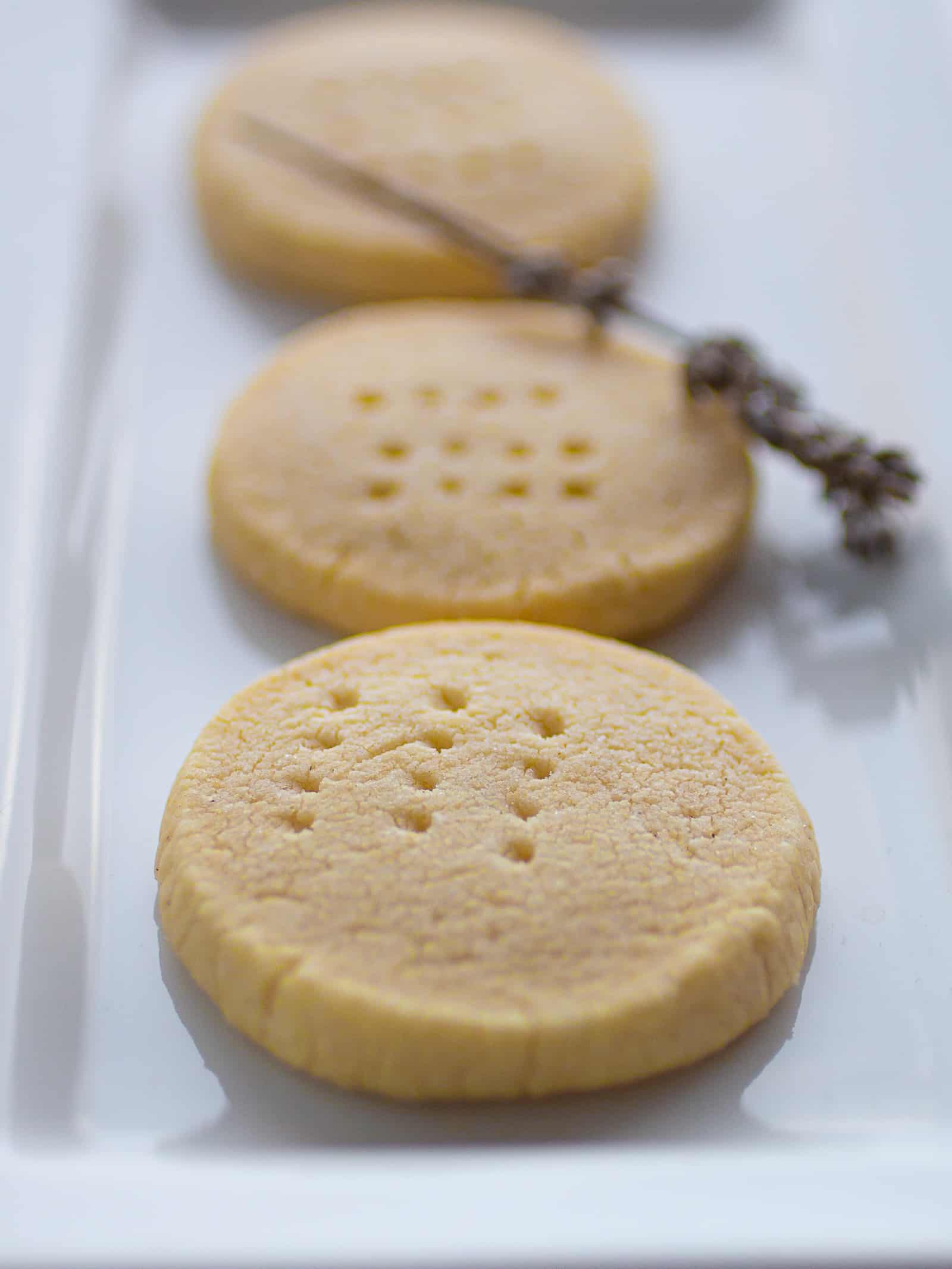
Gluten-free shortbread cookies are rich, buttery, and only require five ingredients to make. Unlike classic gluten-free sugar cookies, shortbread is naturally egg-free. The butter and vanilla are the real stars of the show here. The dough contains just enough gluten-free flour to hold everything together.
Some classic recipes for shortbread contain rice flour. This means the texture of a gluten-free shortbread cookie is very similar to its wheat counterpart. It’s crisp and delicate.
Since the basic recipe is so simple, it welcomes variations. I’ve included a few of my favorites but feel free to play around with this recipe.
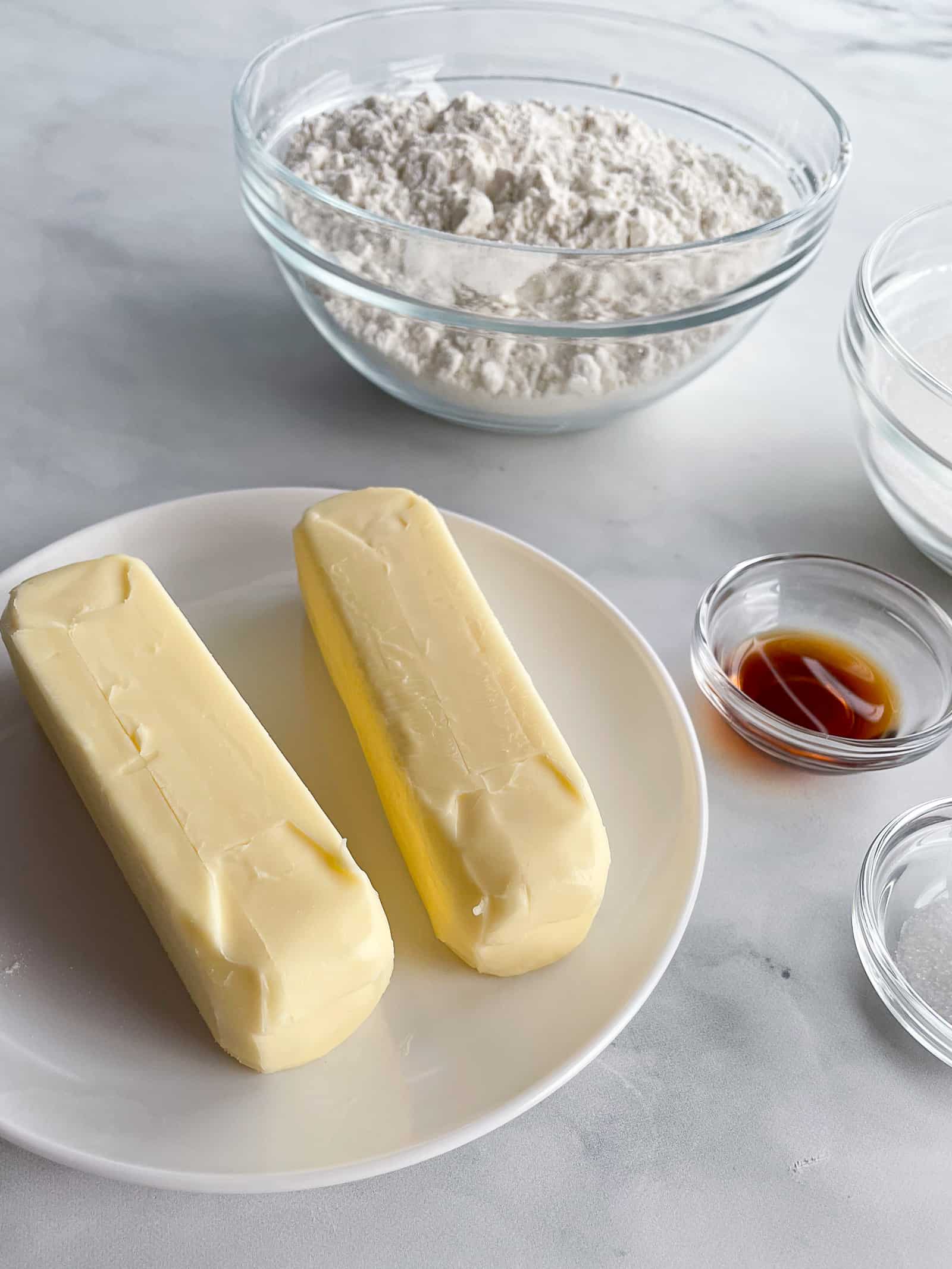
Key Ingredients.
- Gluten-Free Flour. A gluten-free flour blend helps the cookies hold their shape during baking. Look for a blend that contains xanthan or guar gum. (If your blend doesn’t, whisk ¼ teaspoon into the gluten-free flour before using.)
- Butter. Butter is an essential ingredient in shortbread cookies. It gives the cookies flavor and a rich texture. Both salted and unsalted butter work in this recipe but butter is my preference. The salt gives the cookies a deeper flavor and helps to balance the sugar. For gluten-free and dairy-free shortbread cookies, use your favorite dairy-free butter. (See note below for information on gluten-free and dairy-free shortbread cookies.)
- Granulated Sugar. Shortbread’s delicate sweetness comes from granulated sugar. Don’t use maple syrup or honey in this recipe or the cookies will spread.
- Vanilla Extract. A teaspoon of vanilla extract adds flavor.
- Salt. Use fine (table) salt. It blends easily and evenly into the dough. If you only have flaky Kosher salt in the house, increase the salt to 1 ½ teaspoons.
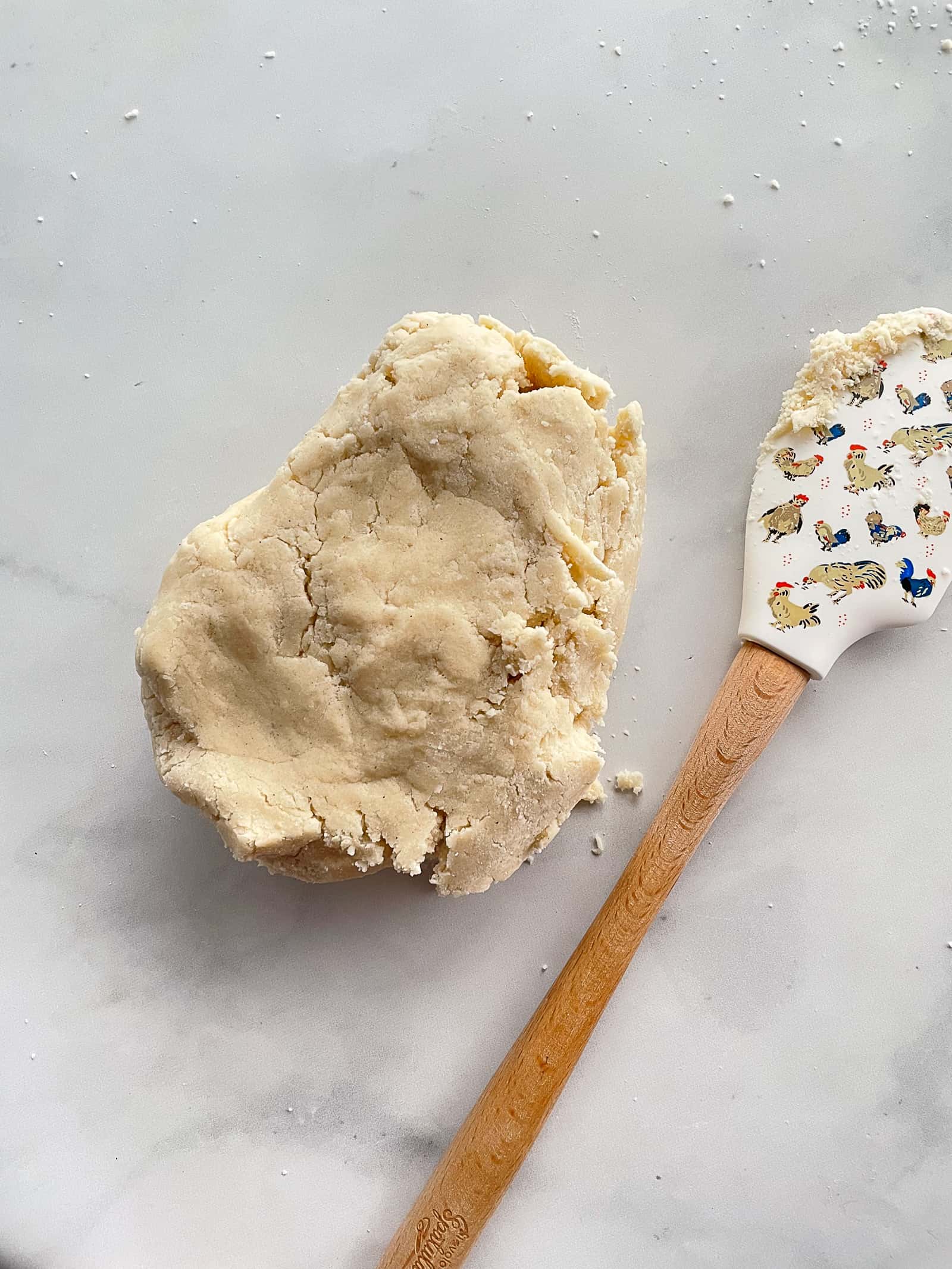
How to Make Gluten-Free Shortbread Dough. Steps for Success.
Gluten-free shortbread is a little tricky to make. Since it lacks liquid, sometimes the dough can be crumbly. Here’s how to make the perfect gluten-free shortbread dough every time.
1. Start with Softened Butter.
The most important step in this recipe is using softened butter. Aim for it to be about 65 to 68℉. You want the butter to feel cool to the touch. If you poke it, look for the butter to give a little resistance but not crack.
If the butter is too cold, the shortbread dough won’t come together. If the butter is too warm, the cookies will spread during baking and turn out greasy.
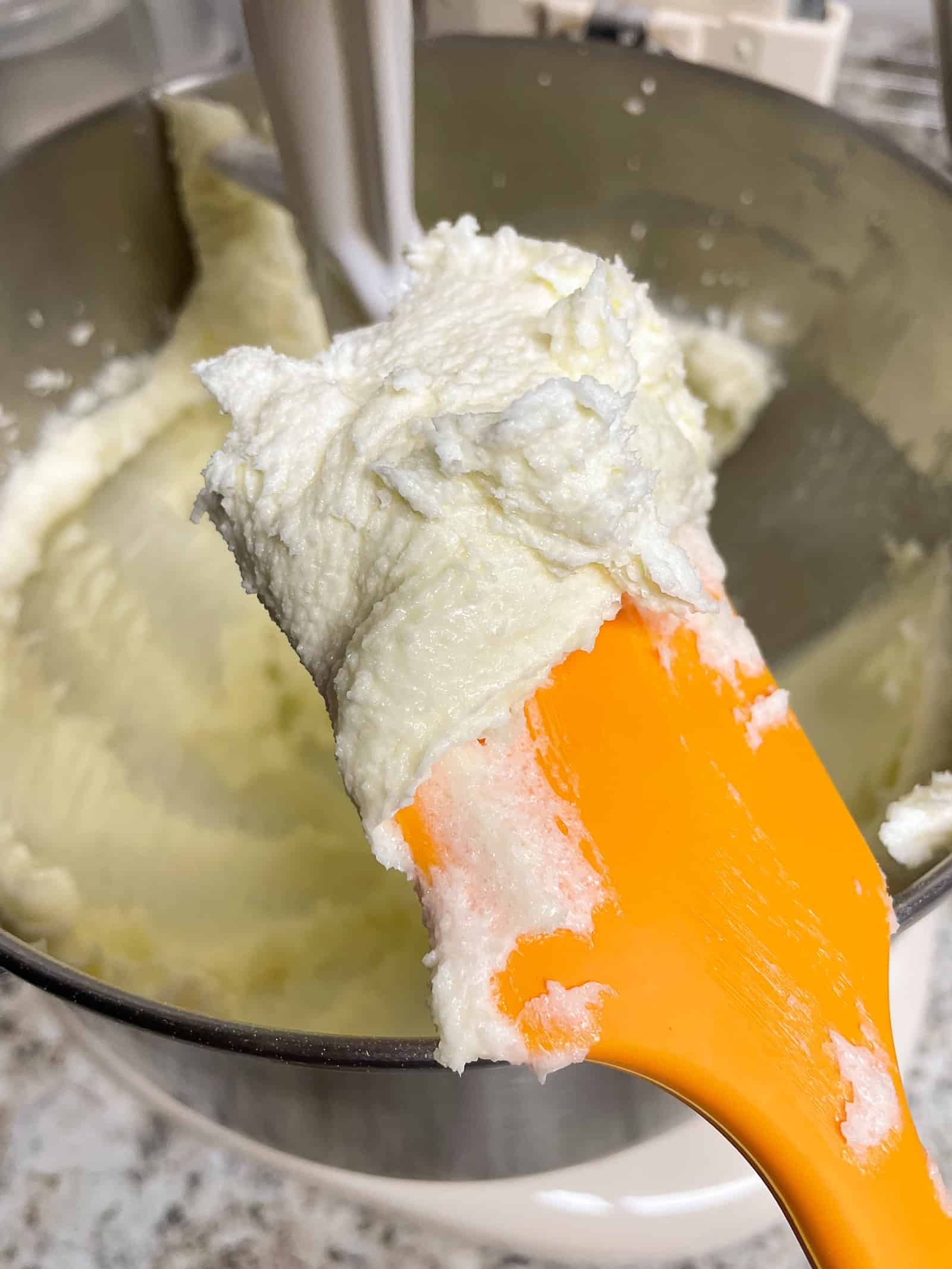
2. Mix the Sugar Until Creamy, Not Fluffy.
The texture of shortbread cookies is one of the things that sets them apart from other butter-based cookies. It’s dense and almost sandy. To achieve this lovely texture, blend the butter with the sugar until it’s thick, not fluffy. If the butter-sugar mixture gets fluffy, like it does for gluten-free pound cake, it traps air. That’s what makes it fluffy. That air causes the cookies to puff and rise, which we don’t want.
Simply mix the room-temperature butter with the sugar and salt until its thick and creamy. This only takes about a minute. It’s a good idea to stop the mixer once and scrape the sides of the bowl. There’s usually a thick layer of butter clinging to the bowl. Mix this in so there aren’t streaks of butter in the finished cookies.
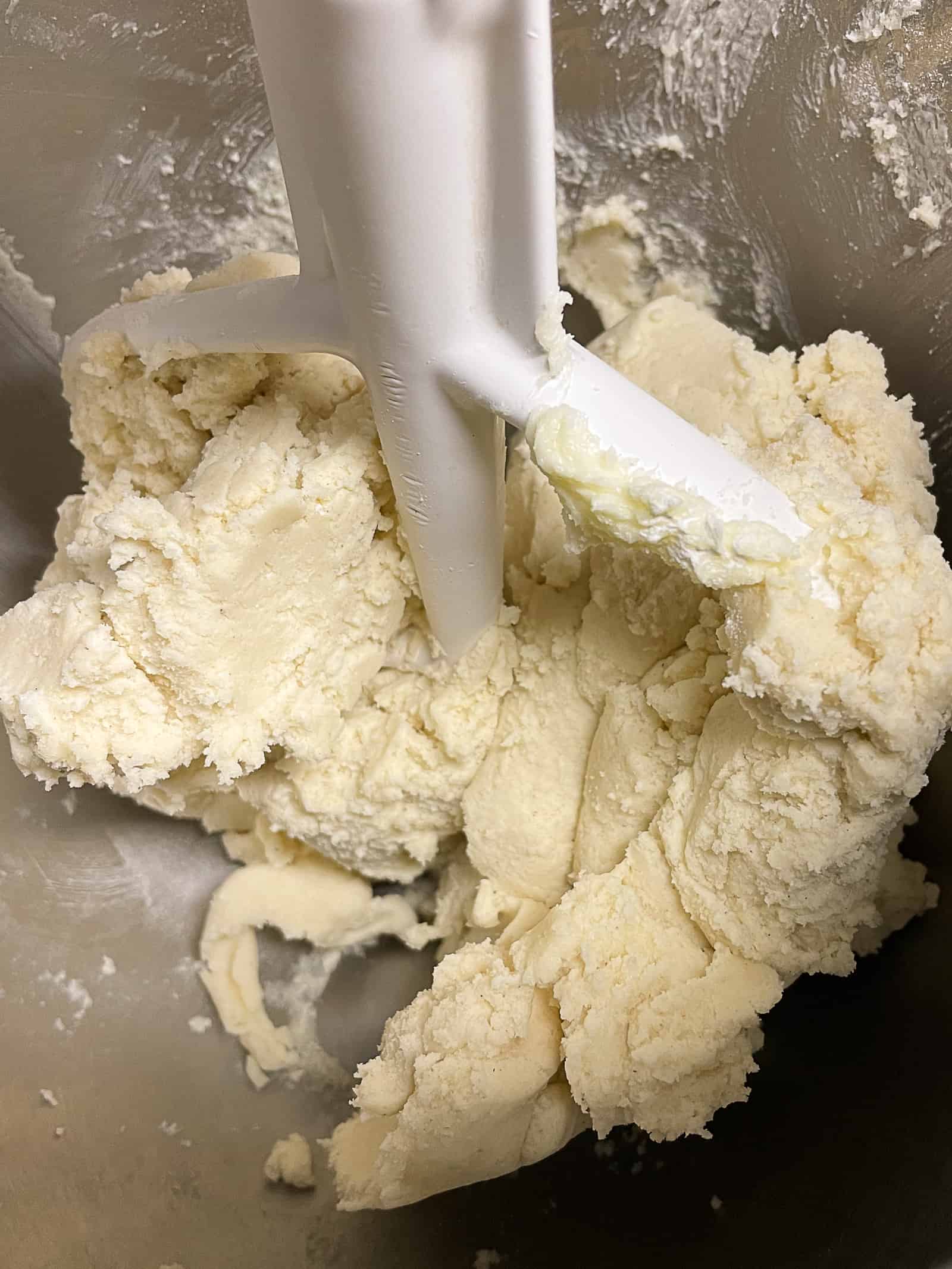
3. Make the Dough.
Since these cookies contain no eggs or liquid ingredients, there’s no moisture to coax the ingredients quickly into a dough. Once the dry ingredients are added to the butter and sugar, it takes a minute or so for a dough to form.
Gluten-free shortbread dough mixed in a stand mixer comes together differently than if mixed with a handheld mixer.
Baker’s Note: How to Make Gluten-Free Shortbread Dough with a Handheld Mixer.

Shortbread dough can look incredibly crumbly and refuse to come together when you use a handheld mixer. This happens because of the shape of the beaters and the power of the mixer. In fact, if you’re using a handheld mixer, you might think there’s something wrong with the recipe at this point.
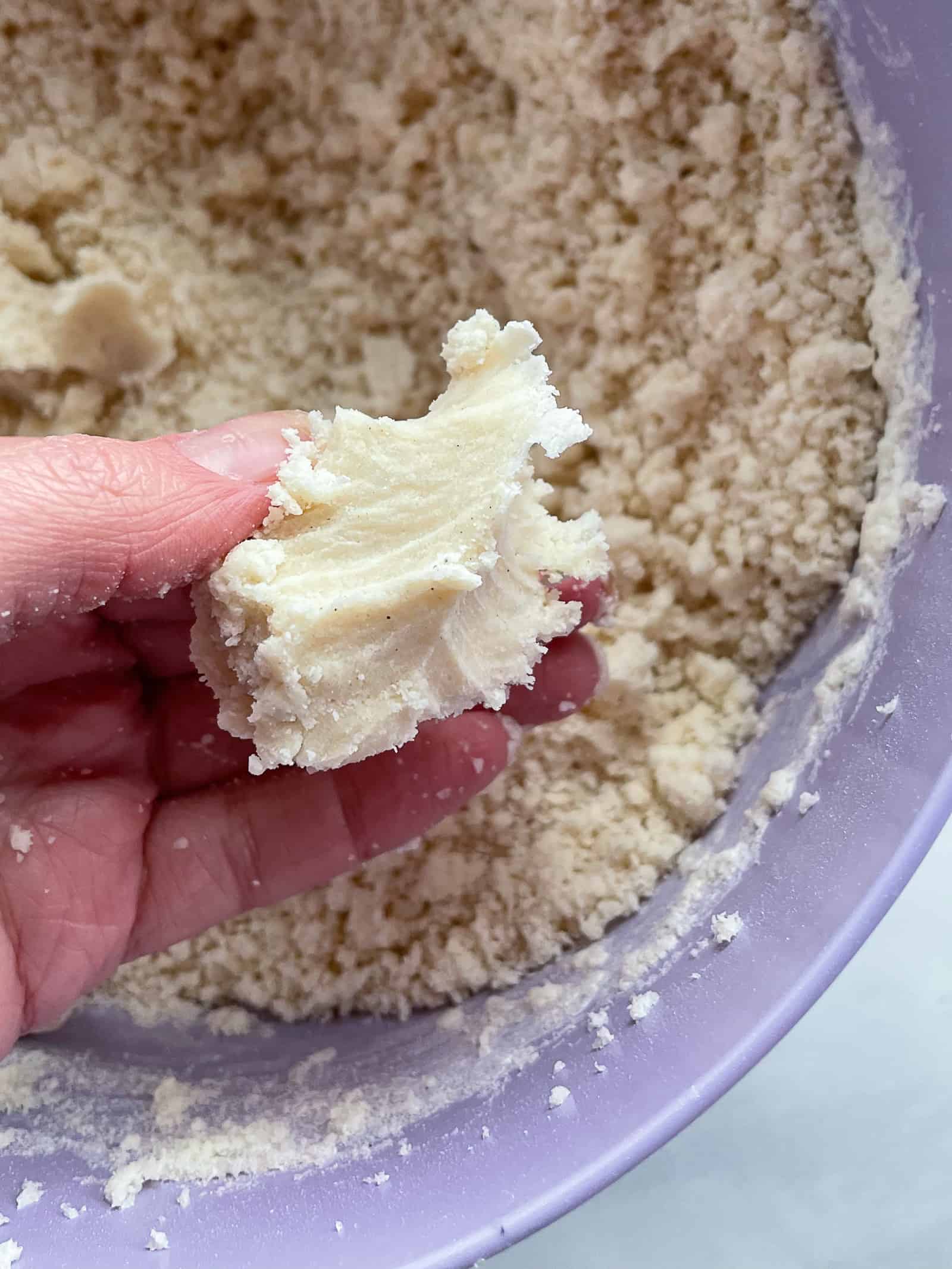
If you’re using a handheld mixer and you notice the dough is sandy or crumbly, stop the mixer. Give the dough a squeeze. If it easily holds its shape, stop using the mixer. Press the dough into a ball with your hands or a rubber spatula. I do this right in the mixing bowl. You can also turn the dough onto a lightly floured counter and knead it a few times.
If you squeeze the dough and it doesn’t hold its shape, add one teaspoon of water. After you add the water, the dough still might appear crumbly. That’s fine. Give it a squeeze. It should come together.
The exception to this is if the butter is very cold. If the dough is cold, let it warm up and try mixing again.
4. Shape the Dough.
From baking the cookies right in a pan to using your favorite cookie cutter, you’ve got options when it comes to shaping these cookies.

Roll into a log.
To make “slice and bake” shortbread cookies, divide the dough in half. Roll into a log about 2 to 2¼ inches across. Cut into rounds. If the dough crumbs when you cut it, gently press it into a round on the cookie sheet.
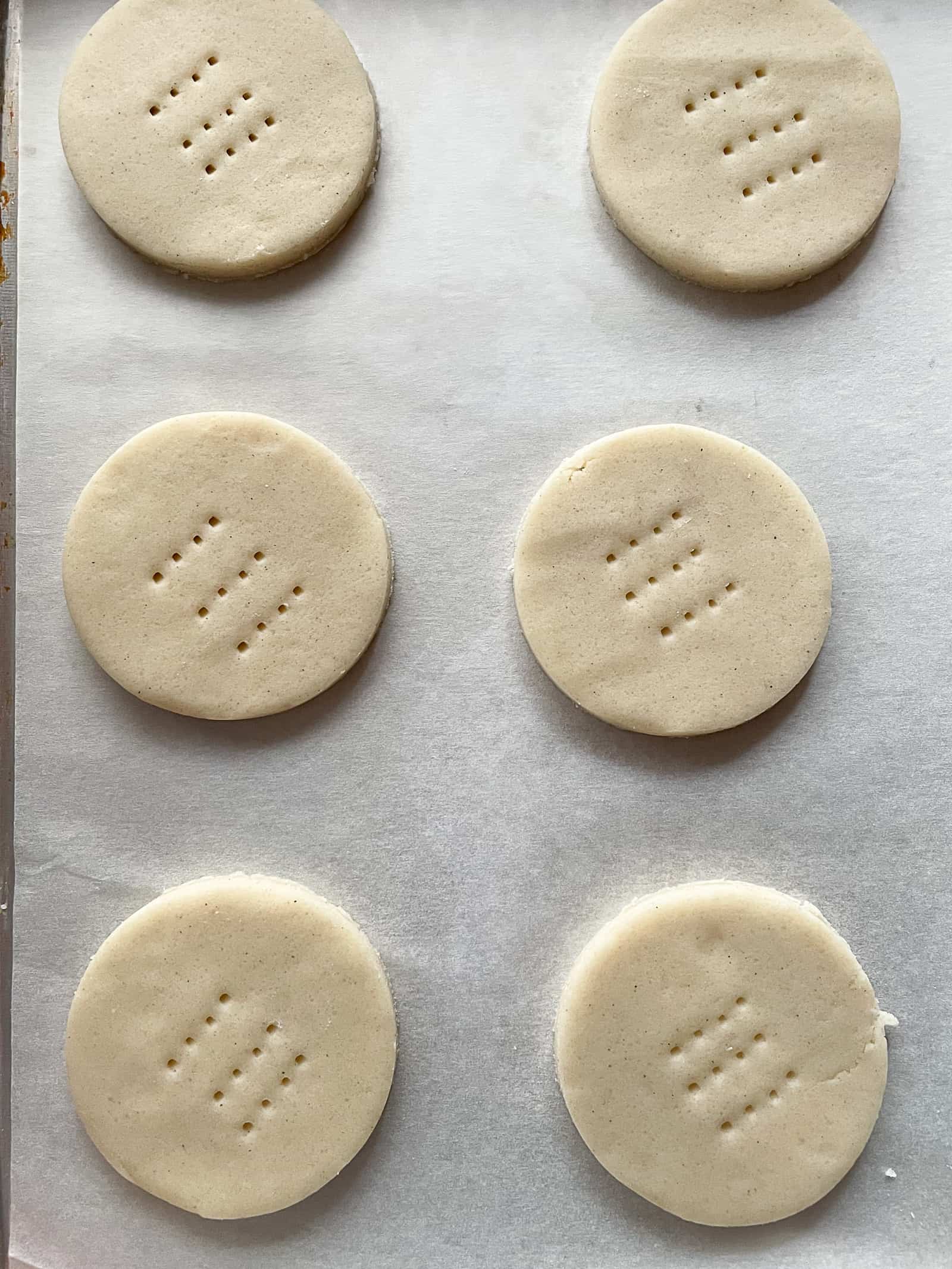
Use a Cookie Cutter.
You can use cookie cutters with this dough. Since it spreads a little during baking, basic shapes, like rounds, rectangles, and stars work best. To use a cookie cutter, dust your counter with gluten-free flour. Roll the dough out to about 1/4-inch thick. Dip your cutter in gluten-free flour and cut.
After cutting out the shapes, gather the remaining dough and re-roll. Since these cookies are gluten-free, they won’t get tough when re-rolled. If you notice the dough is warm after working with it, chill for 20 minutes before re-rolling.
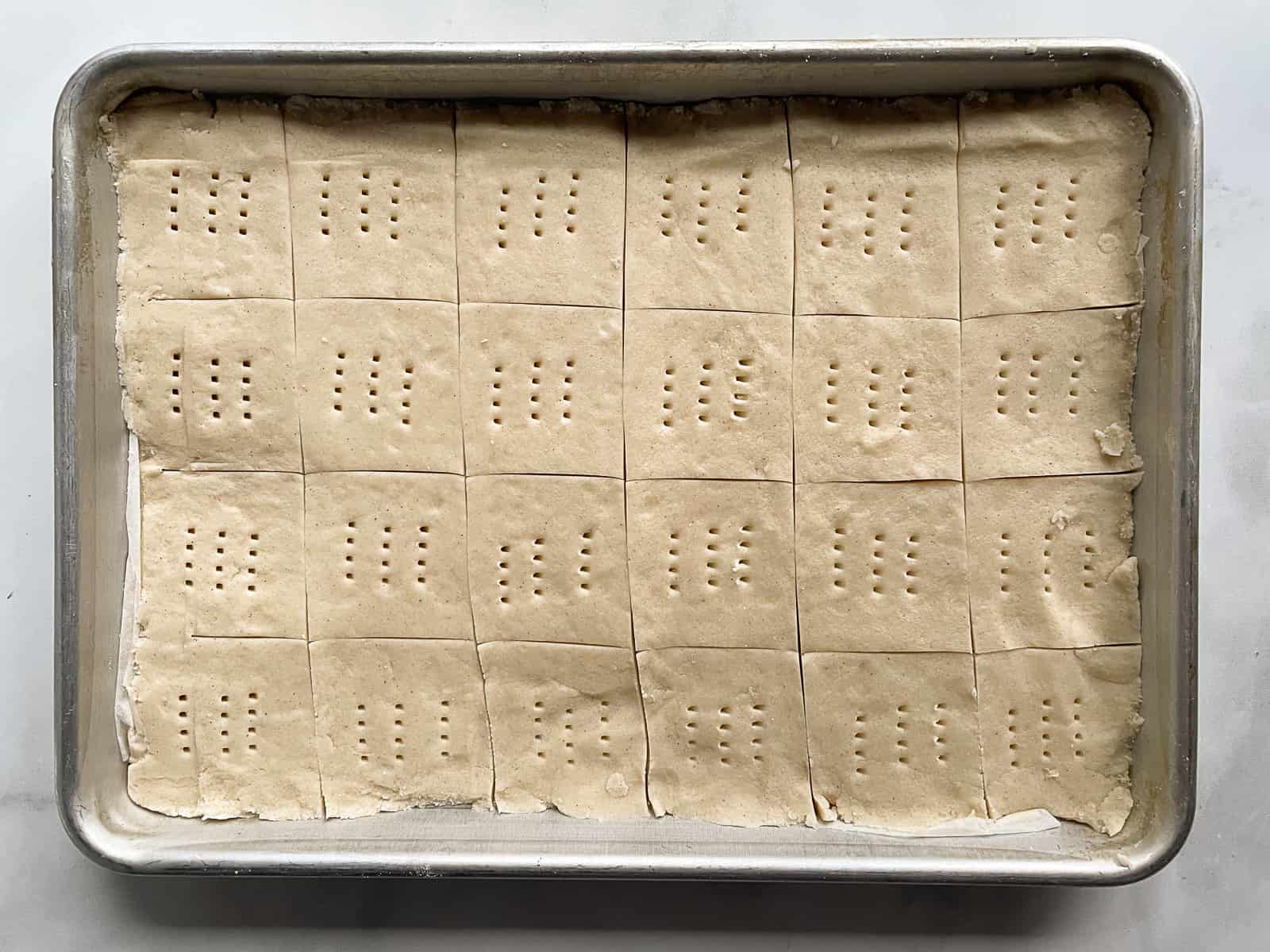
Bake in a Pan.
The easiest way to shape shortbread cookies is to press the dough into a 9×13-inch pan or two 8-inch round cake pans.
Line the pan(s) with parchment paper and grease the sides lightly with nonstick spray. Press the dough evenly into the pan. Score the dough into shapes. I like to make rectangles in the 9×13 inch pan and triangles if I use a round pan. This makes it easy to break the cookies apart after baking.
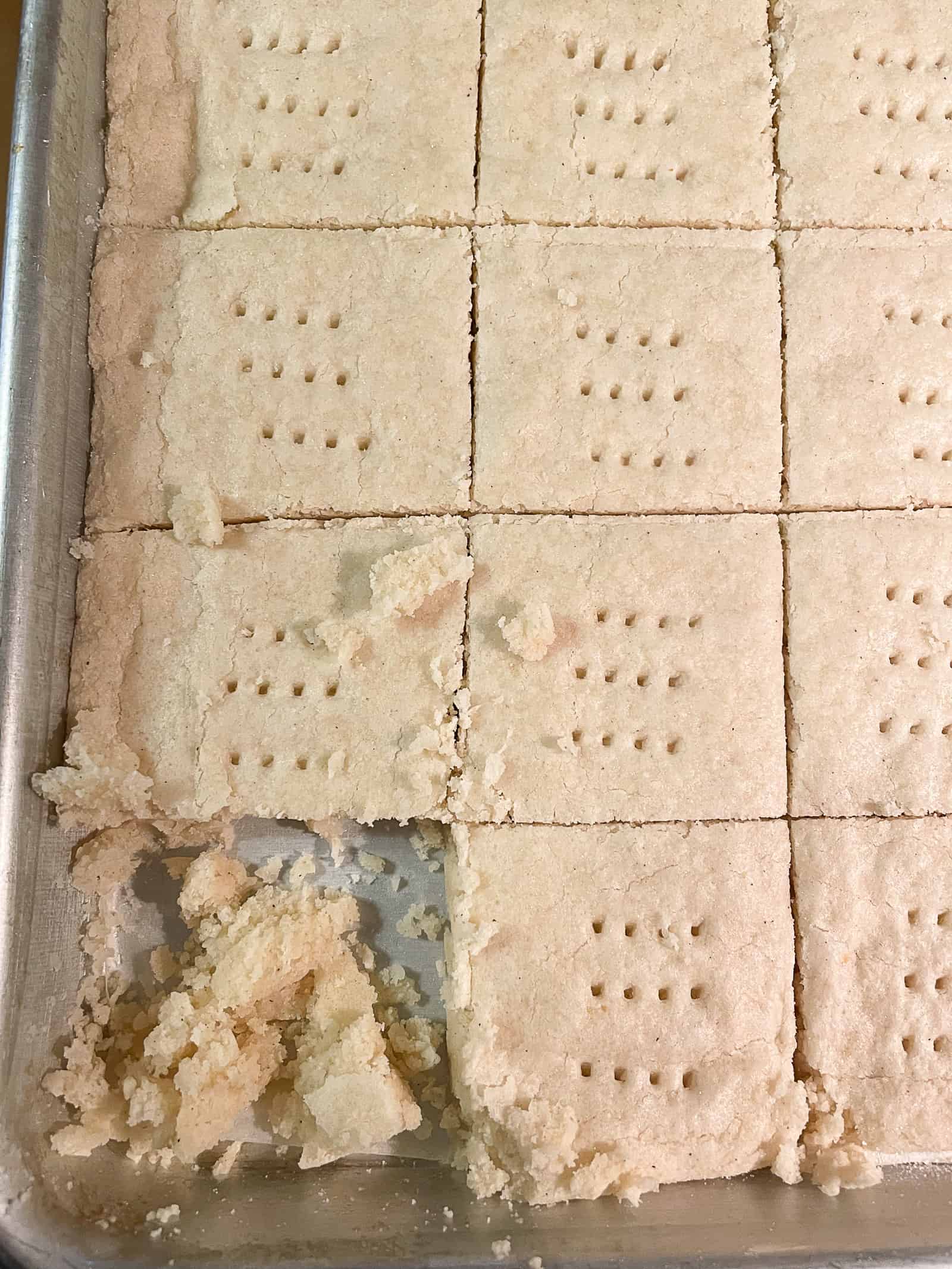
After baking, let the cookies cool in the pan. If you try to move them or cut them right after baking, they’ll crumble.
5. Poke Before Baking.
Whatever method you use to shape the cookies, it’s important to poke the tops gently with a fork. These tiny holes help the steam to escape during baking and keep the cookies from bubbling. To do this, press a fork gently into the tops of each cookie. There’s no need to press all the way through the dough. This might crack it. Instead, press the fork about halfway through the dough.
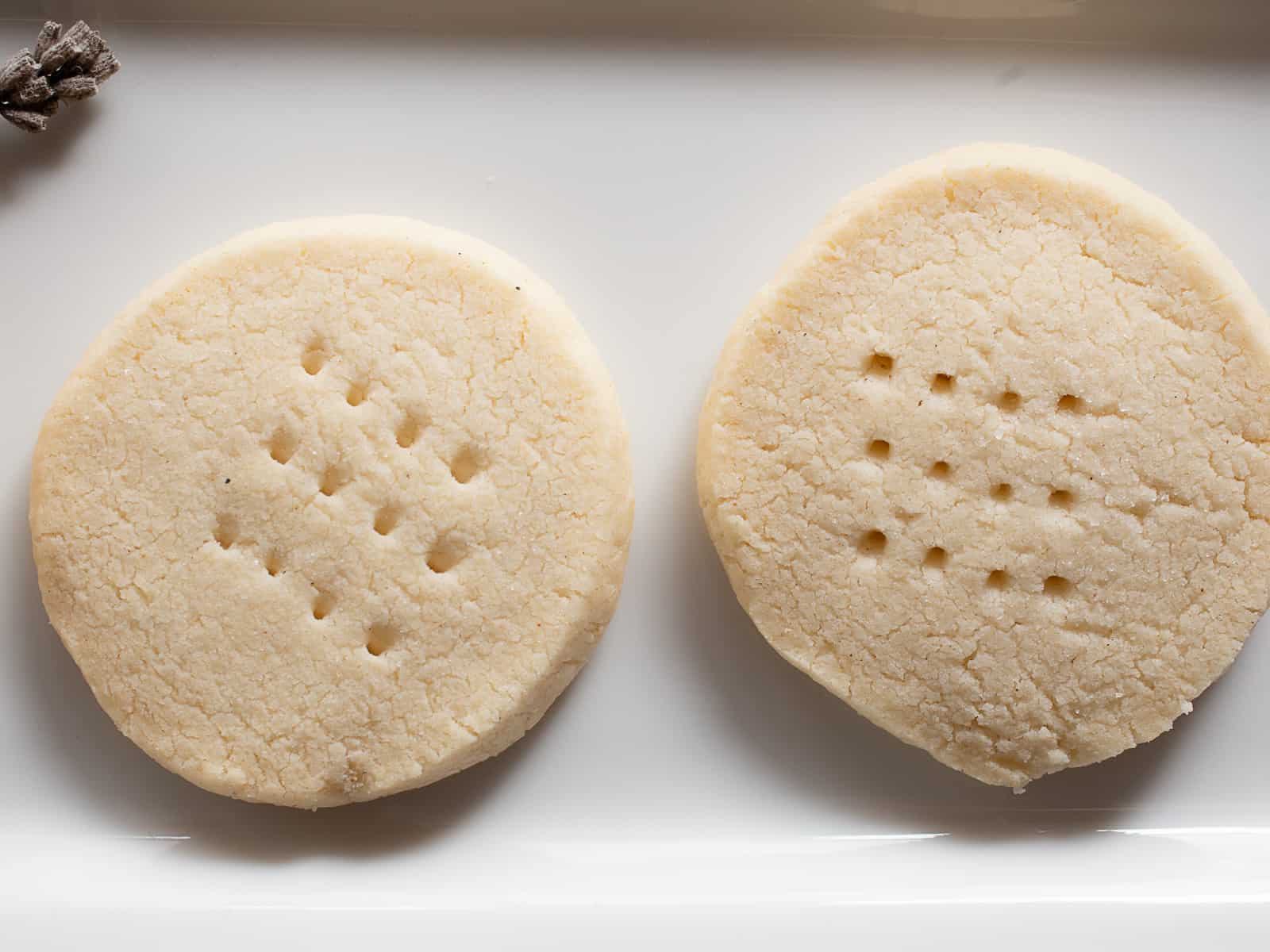
6. Bake Until Set
Shortbread cookies are baked at a lower temperature than most cookies. This low temperature keeps the cookies pale in color and gives them that delicate texture.
So how do you know when the cookies are done? Look for the edges to be a very light brown. The cookies should look set. If they seem shiny or appear dough-like, bake them a little longer. Small hairline cracks often appear on the surface of gluten-free shortbread cookies. This is normal and nothing to worry about.
7. Cool.
Cooling is an important step for these cookies. Since they’re so buttery, they can crumble when warm. If you make individual cookies, transfer them to a wire rack to cool. If you bake your shortbread in a pan, cool them in the pan for at least 30 minutes and then remove them.
Variations.
- Gluten-Free Lemon Shortbread. Add the zest of one lemon and one teaspoon of lemon extract to the dough.
- Gluten-Free Chocolate Chip Shortbread. Replace the granulated sugar with half granulated sugar and half light brown sugar. Add 6 ounces, about one cup, of chocolate chips or chopped dark chocolate.
- Gluten-Free and Dairy-Free Shortbread. For a gluten-free and dairy-free shortbread, replace the butter with your favorite dairy-free butter for baking. If the dough seems too soft, add a tablespoon or so of additional gluten-free flour and chill the dough for 30 minutes before baking.

How to Store Gluten-Free Shortbread
Gluten-free shortbread dough and cookies are good “keepers.” Here’s how to make them in advance and store them.
How to Store Shortbread Dough.
You can make the dough ahead and store it, tightly wrapped in plastic wrap, for up to one week in the refrigerator, or 2 months in the freezer.
Gluten-free shortbread dough gets very hard when stored in the refrigerator. Let it come to almost room temperature before rolling or it will crack. You can cut the cookies into rounds before storing them. If you do, remove the cookies from the refrigerator, place them on a parchment-lined baking sheet and bake them in a preheated oven.
How to Store Baked Gluten-Free Shortbread Cookies.
To store at room temperature: Place the cooled cookies in an airtight container. They keep at room temperature for up to 5 days.
To freeze the cookies: place them into a freezer container. You can separate layers with a piece of parchment or waxed paper. Freeze the cookies for up to two months.
To thaw the frozen dough or cookies: place on the counter for several hours.
Solving Common Gluten-Free Shortbread Problems.
My cookie dough isn’t coming together, what do I do?
- Give it a squeeze. If your dough looks crumbly but easily holds together when squeezed, press it into ball with your hands or a sturdy spatula. Some mixers aren’t strong enough
- Check the temperature. Cold gluten-free shortbread doesn’t come together easily. If your dough feels cold to the touch, let it warm for about 20 minutes and then try mixing again.
- Add a tiny bit of water. If you’ve checked numbers one and two and the dough still won’t come together, stop your mixer and add two teaspoons of water. This should help it come together.
Note: If after checking the butter temperature and adding water, the dough still won’t come together, I’d check how much flour you added. If you accidentally added too much, the cookie dough will remain too dry.
The shortbread dough is very soft and hard to roll/shape.
If your dough is sticky and hard to roll, feel it. If the dough feels warm or at room temperature, cover it and chill it in the refrigerator for 30 minutes. If the dough feels cool, add a tablespoon of additional gluten-free flour.
The dough is firm and hard to roll.
If your dough is cracking and hard to roll, cover it and let sit for 20 minutes. It might be too cold. If that doesn’t fix the problem, add a teaspoon of water and mix until a dough forms.
The Cookies Spread.
These shortbread cookies should hold their shape during baking. If they spread into thin cookies, a few things could have happened.
- The butter might have been too warm. If you make the dough with very soft butter or the dough warms up (gets squishy) before baking, the cookies can spread.
Next time, keep the butter at room temperature. If the dough gets warm before baking, chill it for about 15 to 20 minutes before baking the cookies.
- Too much liquid was added. More than about two teaspoons of liquid can cause the cookies to spread.
- The gluten-free flour. Each brand of gluten-free flour bakes differently. I tested this recipe with Bob’s Red Mill 1:1 Gluten-Free Baking Flour. Be sure your blend contains xanthan or guar gum. This is key to helping the cookies hold their shape.
- Measuring mistake. It happens to even the best baker: a measuring error. If the cookies didn’t have enough flour or contained too much butter, they will spread.
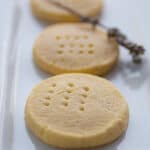
Gluten-Free Shortbread
This gluten-free shortbread recipe makes cookies that are rich and flavorful. The texture is wonderful: slightly crumbly in the best way. The cookies are egg-free and can be made dairy-free.
Ingredients
- 1 cup butter, softened (about 68℉) (2 sticks; 8 ounces; 198 grams)
- 1 teaspoon salt
- ¾ cup granulated sugar (5 ¼ ounces; 148 grams)
- 1 teaspoon vanilla extract
- 2 ½ cups gluten-free flour blend, see note (12 ounces; 345 grams)
Instructions
-
Preheat oven to 325°F.
-
Combine softened butter, granulated sugar, and salt in the bowl of a stand mixer or in a large mixing bowl.
Mix until thick and creamy, about one minute. Use high speed with a handheld mixer and medium-high speed on a stand mixer.
Stop the mixer and scrape the bottom and sides of the bowl. Add the vanilla extract. Mix for an additional minute. Add the gluten-free flour.
-
Stand Mixer directions: mix for about two minutes on medium-high speed. Be sure to use the flat paddle attachment.
Stand mixer directions: Mix on high speed. If the dough seems crumbly after two minutes, stop the mixer. Squeeze the crumbs. If they hold together, press the dough into a ball with your hands or a sturdy rubber spatula. If the dough does not hold together when squeezed, see note below.
-
Shape the Dough.
For slice and bake cookies: divide the dough in half. Dust your counter with gluten-free flour. Knead the. dough a few times until smooth. Then roll out into a log, about 2 inches in diameter. Use a sharp knife and cut into rounds, about ½-inch thick. Place the cookies onto a parchment-lined baking sheet, about 1 inch apart.
For cut-out cookies: Lightly white rice flour your countertop. Turn dough out onto counter and shape dough into a disk. Using a rolling pin, roll dough out, about ½-inch thick.
Cut into shapes. Dip your cutter into gluten-free flour to keep the dough from sticking to the cutter. Place the cookies onto a parchment-lined baking sheet, about 1 inch apart. Gently knead leftover dough into a ball and re-roll. If the dough gets warm, chill it for about 20 minutes.
For a pan of cookies: Lightly grease one 9×13-inch pan or two 8-inch round pans. Line with parchment paper. Press dough evenly into the pan. Score into 24 cookies for the 9×13-inch pan and cookies and about 8 triangles each for the 8-inch round pans.
-
Poke small holes into the tops of each cookie. Do this for the slice and bake, cutouts, and pan of cookies. You want about three rows of holes per cookie.
Bake until the cookies are set, about 35 minutes. Look for the edges to be lightly golden brown.
Transfer individual cookies to a wire rack. For a pan of cookies, allow the cookies to cool right in the pan.
-
Store cookies in an airtight container for up to one week. Or freeze the cooled cookies for up to two months in a freezer container.
Recipe Notes
Gluten-Free Flour.
Use a gluten-free flour blend that contains xanthan gum. If your blend doesn’t contain xanthan gum, whisk ¼ teaspoon into the flour before using.
How to Fix Crumbly Dough.
If your dough is crumbly and isn’t coming together, here’s how to fix it:
- Give it a squeeze. If your dough looks crumbly but easily holds together when squeezed, press it into ball with your hands or a sturdy spatula. Some mixers aren’t strong enough
- Check the temperature. Cold gluten-free shortbread doesn’t come together easily. If your dough feels cold to the touch, let it warm for about 20 minutes and then try mixing again.
- Add a tiny bit of water. If you’ve checked numbers one and two and the dough still wont’ come together, stop your mixer and add two teaspoons of water. This should help it come together.
Note: If after checking the butter temperature and adding water, the dough still won’t come together, I’d check how much flour you added. If you accidentally added too much, the cookie dough will remain too dry.



Janet Wells says
My husband has celiacs so I am always looking for good GF recipes. These were amazing. I will say that I did a small substitution. I used Bob’s Redmill 1:1 flour (it has Xantham gum in it) and then used coconut flour for the sweet flour. Turned out fantastic! Husband, son, SIL and everyone else loved them. Works well w a little lemon peel zested in for flavor too.
Also I made bars – easy to do in a shallow pan roughly 8×10. Pre-slice before baking and it will make for easy slicing afterwards. Also these are amazing dipped fully or partially in Godiva’s melting dark chocolate.
Thank you for this amazing recipe. It’s going to be a go- to for holiday gifts.
Siobhan Mac says
Thank you for these!!! I love them. I didn’t have rice flour, so used my GF flour for both the rice flour parts and then the corn flour. They came out beautifully. I think this would make an excellent pie crust for something like Lemon Tart or Lemon Tart. I can’t wait to try it for that! I also want to try it with caster sugar next time. But otherwise it’s wonderful
Pilotte Christine says
thank you from a celiac..I am a fan of Bobs Red Mill 1 for 1 flour. The cookies are baking now.
Ciaran Broadbery says
thank you Elizabeth for your recipe (Gluten free Shortbread) really works. I have added fudge and chocolate chips after I roll out and before I cut into shapes and this works terrific. I can get the fudge and chocolate chips in most stores ..tesco Lidle Aldi etc. the are already in tiny pieces..Thank You Elizabeth!!!!!
What I would love from someone is a recipe for Gluten -free (wheat free-yeastfree daity free) bread but one that turns out ” SOFT”. I generally make it with oats/oatflour etc..but it never turns out soft. no matter what i do.!!
Ciarán
April says
Lemon zest, lemon oil, and some powdered ginger, finely chopped candied ginger makes a mouthwatering cookie, too,
Janet says
These are perfect!
Bianca Stark says
I’m sorry but this didn’t turn out right at all. I was dubious from the get go as it seemed a very soft mix. Turned out like flat pancakes joined together. I followed the recipe exactly apart from using all rice flour as I was unable to source sweet rice flour, not sure if that’s why but they’re so far from working I’m not even going to try and tinker with this recipe to get it to work. Very disappointed.
Elizabeth says
Hi Bianca,
I hope you didn’t toss the dough. Two things would probably solve this quickly. A tablespoon or so of white rice flour and an hour-long chill in the fridge. It sounds like the butter is a little too soft. That’s it.
Wilma Pawluk says
Pretty much the For me, except thafthe dough was soft and when baking, spread out into much like a bar. Will bake anyway and use them as bars, I guess. Disappointing.
Elizabeth says
That’s disappointing.Let’s see if we can get to the bottom of this. Soft dough can happen when the butter is too warm. Did you chill the dough for 30 minutes like was suggested in the post? That usually solves this problem. And what gluten-free flour blend did you use?
Chrishy says
I made these today, and there were way better than expected. I expected more grit, but they were really close to the read deal (a little sweeter). I also really appreciate the fact you only put the minimal amount of xanthan needed. I did have to add 2 tsp of water as suggested. I was wondering if I added an egg yolk, do you think I could make them into danish butter cookies that could be piped?
Thanks again! We also made your battered fish recipe, and we were VERY impressed. JUST like the kind you can get in the pub. Might have to give your poutine recipe a try. Being Canadian and deprived of it is just not right. 😛
Elizabeth says
Ooooh. Good question about the Danish Butter cookie. I have a gluten-free spritz recipe that uses an egg. I think you’ll find that recipe very similar to what you’re looking for in a piped cookie.
Chrishy says
I made these again! I made a few adjustments to be closer to our families recipe which calls for 100g of sugar, and no extracts. Wowser!!! DELISH. My new go to! Thank you so much for this 🙂
chrishy says
Me again 🙂 So these cookies are amazing. My only issue is the longer they age (3-4 days+), the grittier they become. It’s the thai flour, which is pretty finely ground anyway. Could I add/sub a small amount of almond flour to slowly hydrate them a little longer? If so, what plan of action do you recommend? I don’t want to interfere with the amazing butter taste at all. I did reduce the sugar in this batch, but they both had the same issue regardless of sugar content. If I was serving these the next day or day after, I would not hesitate to serve these to gluten eaters bc I feel they are that good! Thank you so much for everything you do 🙂
Theresa says
These turned out great! My first time making gluten free cookies!
I had to substitute potato flour for the sweet rice flour, and added dried lavender but otherwise followed the recipe. The texture was perfect, and absolutely lovely for dipping in coffee. One note on the flavor, I probably should have used unsalted butter (the recipe didn’t specify) because they turned out a bit on the salty side. Next time I would use unsalted butter or reduce the salt. We brushed them with egg whites and sprinkled them with decorator sugar for a little extra sparkle.
Donna says
I tried these again, doing exactly what you recommended, including refrigeration before baking, and they flattened out again. I’m using Bob’s Red mill flours. I used superfine sugar. I’m about ready to give up on this recipe, unless you have a suggestion. I’m at 2k feet above sea level. But I can’t imagine would be a factor, would it?
Elizabeth says
Urgh. I’m sorry you’re encountering this issue. I’ve made them many times and haven’t had them spread. I’ll make a batch tonight and see if I can see what might be causing the issue.
One question: are you measuring by weight or volume?
Donna says
With the holidays, I’m assuming you missed my last message. Wondering if you might have any more insight?
Elizabeth says
Donna! I’m sorry. You’re right. I didn’t see your last message.
I’ve tested this recipe a few times since you left your comment, hoping to get it to spread. While I haven’t experienced that issue, I do know a thing or two about cookies that spread. ? My guess/hope is that a few tablespoons more rice flour would do the trick.
As long as the butter isn’t too soft (which it sounds like you’ve addressed), I think the next logical thing to try would be additional flour.
B.F. says
I’ve heard Bob’s Red Mill can be very inconsistent, and also baking at a high altitude most DEFINITELY affects baking! You should research on how to make adjustments
Gillian Sharp says
I think the issue could also be using superfine sugar, as it has a different melting temp. I made the recipe exactly as stated using grams weight, no spread, cooked to perfection.
I made them into Scottish Empire Biscuits which my husband loves but you can’t buy them GF.
Use 2 shortbread and strawberry jam to join together, top with thick water icing and stick a jelly tot in the middle on the top.
,
Cindy says
Are you using a less expensive house-brand butter by any chance? I stick with Land o Lakes now most every time I’ve used the house brand cookies spread. All US butter has to be at least 80% butter fat BUT the remaining 20% can contain more water vs butter fats and this hells keep the price down. Professional bakeries often use European butter which is 82-90% butter fat.
JJ says
If you substitute a 1:1 flour like Bob’s GF flour, do you omit the xanthan gum and still add sweet rice flour, corn starch?
Elizabeth says
No, you would substitute all of the flour and starches for the Bob’s Red Mill. For this recipe, use 2 1/3 cups Bob’s GF flour and omit the xanthan gum.
Hope that helps!
Lainey Finney says
I believe the salt and baking powder amounts are transposed. Should be 1/4 tsp salt and 1 tsp baking powder perhaps. Wonderful recipe otherwise!
Elizabeth says
No, the amount of salt and baking powder are correct as listed. If a full teaspoon of baking powder was listed, they would not have the classic, dense shortbread texture.
Glad you enjoyed them!
Donna Scher says
This dough is not good for rolling cookies. After the 3 minutes you can sort of force it into a ball but when you try roll it is crumbles. You can force it into a flat solid piece if you take a few minutes just with about 1/4 of the dough. If you use a cookie cutter, it takes about 30 seconds to ease it out of the cookie cutter on to the baking sheet, still with a break or two that has to be pushed back into place. Re-rolling the bits is even worse as the bit of rice flour on the board just makes it more crumbly. And yes, I measured the butter exactly and all ingredients were at room temperature. Don’t try this recipe unless you have a high frustration tolerance. There is something about the recipe that just doesn’t work. Maybe in a very warm kitchen the dough would be workable.
Elizabeth says
Hi Donna!
I’m so sorry you experienced trouble with the recipe. Your comment inspired me to re-test the recipe this afternoon. I did and posted the video to facebook.
I used cool butter (About 63 degrees) and did not work in a warm kitchen. In fact, I didn’t work in a kitchen at all. I worked in the area where I develop recipes, which is decidedly cool in an upstate NY winter.
My dough rolled out really well.
I’m not sure what would have caused your dough to be so dry and crumbly. What brands of gluten-free flour did you use?
If you’d like to see the video, I posted it here: https://www.facebook.com/GlutenFreeBaking/posts/4171611109521296
Helen says
I’ve made this recipe numerous times using coconut oil rather then butter. Often this means adding a little more rice flour, but I had a good result everytime! I’ve also never used the gum, as my husband can’t tolerate it (nor dairy, hence the coconut oil). Sometimes I sub a bit of the rice flour for almond or oat flour which I find alters the texture a bit and it still holds up. And usually I put in only half a cup of sugar or less, as we are trying to reduce sugar. I even made them once with half coconut oil, half bacon fat, as I didn’t have enough oil! These cookies are pretty hard to screw up if you pay attention to the dough texture.
One thing I do that isn’t in the recipe, but might make things easier for some people, especially in summer or if they live in a warm climate, is that before I chill the dough I roll it into a fat sausage. Then after it’s been chilling for about 20 minutes I take it out and slice it into rounds rather than rolling and using cookie cutters. This reduces handling time, and the biscuits go in the oven still cold. They keep their shape well and don’t spread really, even without the gum, though they will be a bit more rustic in shape. I slice them about a centimetre thick.
Victoria says
Thanks so much for this recipe! We are a gluten-free family, but are also sugar free. I followed your recipe, but substituted tapioca flour for the cornstarch, and Lakanto sugar-free Powdered monkfruit for the sugar, and was so happy that they were still DELICIOUS!
Thanks again, I will make these over and over 🙂
Krysta says
These were great. I’ve been nostalgic for the shortbread from the Scottish bakery I worked at in high school. This totally did the trick. I followed the recipe meticulously, used Cup 4 Cup Gluten Free flour, and did the pan bake method (this is how we made them in the bakery). They turned out great. I’m glad to have an alternative option to paying $7-8 for Walker’s GF Shortbread that has less than a dozen cookies in a box. Much better homemade, right out of the oven!
Lindsay says
So I’m not sure if you’ve tweaked this recipe so many times and joe have omitted some ingredients but one comment says something about the salt and baking powder being switched measuments…however I reread as I thought oh shoot that’s where I went wrong no baking powder but there isn’t any in the ingredients but I halved the recipe and possible didn’t add as much flour as I should have , but maybe double check your ingredients list.
Elizabeth says
The original recipe, which used a blend of gluten-free flour and starches, contained baking powder. To simplify things, I removed it when I updated the recipe to use a gluten-free flour blend. Since it was a tiny amount of baking powder, I happily found that leaving it out did not really impact the texture of the cookies.
Carolie says
I attempted to make these cookies this morning because I was awake at 4 am and wanted to make some Earl Grey Shortbread cookies to take to work with me. I’m a decent home baker and am gluten free. This past year has been the first time I’ve actually dedicated myself to GF baking, usually I’ll just bake the recipes I love with regular flour. I attempted this recipe and it was definitely too soft but that was probably user error, the butter was more room temp. But the batter was also SO wet. When I was measuring, I always measure by weight. I deemed I did have enough gluten free flour (HEB blend is the one I use because it’s always worked and it’s cost effective) but when I weighed it, it was VERY clear the volume was not matching what I expected with the weight. I decided to just measure with a cup measure because I wouldn’t have enough if I did it by weight by a long shot. It seemed almost double the volume that would match the weight, if that makes sense. I figured I could add flour and ended up using the rest of the gluten free flour I had (about 280 g) and had to add about another cup of just oat flour (it’s what I had) till the dough at least wasn’t sticky to touch. The only other difference was that I added the Earl grey tea to the flour. Is this something you’ve experienced with the weights of gluten free flours? I’m guessing now weight would have worked. I’m letting the dough sit in the fridge for a while and will still bake it and see what happens.
Elizabeth says
Since gluten-free flour blends so greatly by the maker, the weight can vary.I haven’t used HEB flour. So I can’t say what a cup usually weighs. As long as you used 12 ounces (345 grams) of a gluten-free flour blend it should work. As noted in the recipe, the gluten-free flour needs to contain xanthan or guar gum. If it doesn’t, the dough might not come together.
The dough not have been wet. In fact, it’s usually crumbly at first. If the butter was very soft, I expect the dough might have felt soft but not wet.
Hopefully chilling it helped!
Rosy says
This recipe is so easy and produces the best GF shortbread that I have made … I am Scottish and have made normal shortbread my whole life ..husband and son were diagnosed coeliac a couple of years ago and I have been searching for a decent recipe ever since!
I make a roll with the dough and slice it to bake in rounds and that way you don’t handle it too much. Follow the recipe weights and the instructions and you can’t go wrong.
Alison says
Can you tell me why the recipe was changed? Comments refer to rice flour, but there is none listed.
Millie L Barnes says
Horrible recipe. Cookies turned out hard as rocks.
Elizabeth says
Hmmm…these shouldn’t be hard at all. Especially with a full cup of butter to one and half cups of flour. I’m sorry this happened. Let’s see if we can get to the bottom of this.
What type of gluten-free flour did you use? And do you remember how long they took to bake?
Gillian says
Omg these cookies are sooo addictive!! I’ve made these twice in one week already (lol); the first time, I did the slice-and-bake method, and the second batch were cut-out cookies. Both versions turned out perfectly: crisp yet tender and oh-so delicious! I used King Arthur GF flour (which I weighed instead of measured & it worked like a dream), and I sprinkled a tiny bit of water (not even a tsp) into the cut-out cookie dough to make it a bit more pliable, though it wasn’t totally necessary.
I recently had to go gluten-free, and as a baker and pastry lover, it broke my heart. These cookies totally fulfilled my shortbread craving this holiday season, and even my gluten-tolerant friends and family were genuinely shocked to learn that these were gluten-free! Safe to say, these have become my new go-to GF replacement for shortbread and sugar cookies alike. Thank you for bringing delicious cookies back into my life that I can actually eat — it’s recipes like these that make me feel encouraged and hopeful again as a GF baker/newbie!